Date 21 October 1966 | ||
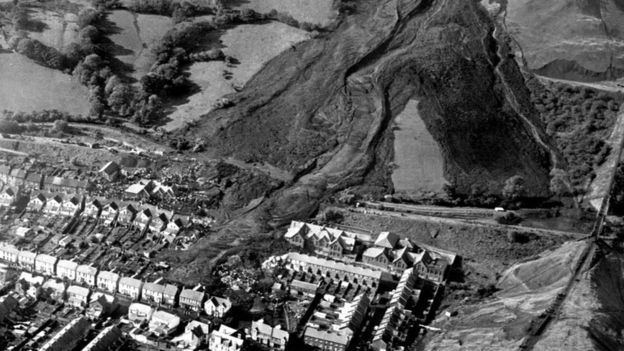 | ||
Total number of deaths 144 (28 adults, 116 children) Similar Gresford disaster, Senghenydd colliery disaster, Buffalo Creek flood, Gleision Colliery mining ac, Flixborough disaster | ||
Aberfan disaster what happened 50 years ago
The Aberfan disaster was the catastrophic collapse of a colliery spoil tip in the Welsh village of Aberfan, near Merthyr Tydfil, that killed 116 children and 28 adults on 21 October 1966. The collapse was caused by the build-up of water in the accumulated rock and shale tip, which suddenly slid downhill in the form of slurry.
Contents
- Aberfan disaster what happened 50 years ago
- Aberfan disaster documentary
- Background
- Collapse
- Rescue efforts and retrieval of the bodies
- Lord Robens
- Aftermath
- Davies Inquiry
- Compensation
- Consequences for NCB and its personnel
- Disaster fund
- Legislation
- Subsequent events
- References

More than 1.4 million cubic feet (40,000 cu metres) of debris covered a section of the village in minutes. The classrooms at Pantglas Junior School were immediately inundated; young children and teachers died from impact or suffocation. Many noted the poignancy of the situation: if the disaster had struck a few minutes earlier, the children would not have been in their classrooms, and if it had struck a few hours later, they would have left for the half-term holiday.
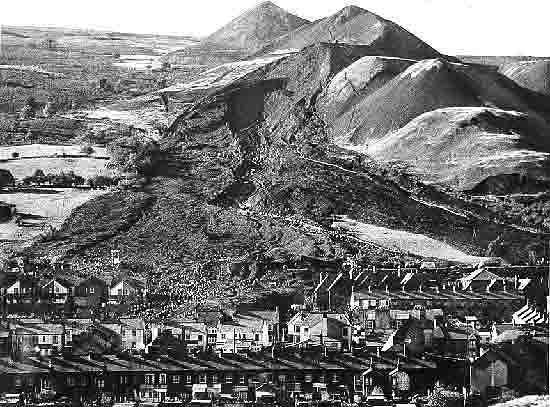
The official inquiry blamed the National Coal Board (NCB) for extreme negligence, and its chairman, Lord Robens, for making misleading statements. Parliament passed new legislation regarding public safety in relation to mines and quarries.
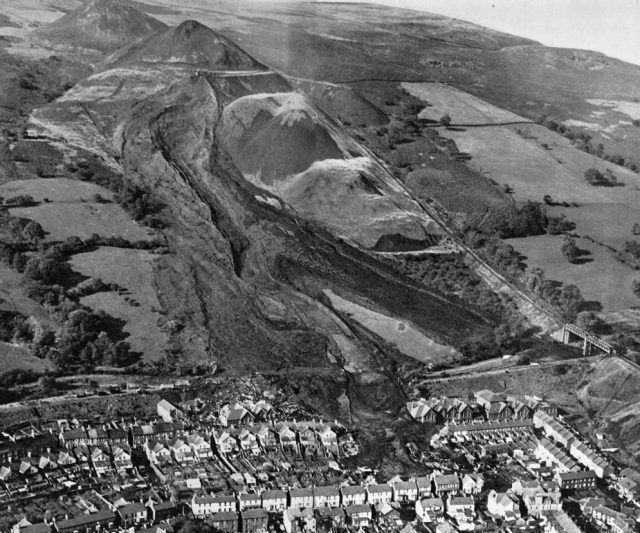
In 1966 the Aberfan Disaster Memorial Fund (ADMF) received 90,000 contributions and reached a total of £1,606,929. The remaining tips were only made safe after a lengthy fight by Aberfan residents who were resisted by the NCB and Labour Government of Harold Wilson. Clearing was paid for by a government grant and forced contribution of £150,000 taken from the charity fund. In 1997 Tony Blair's New Labour Government paid back the £150,000 to the ADMF and in 2007 the Welsh Assembly donated £1.5 million to ADMF as recompense for the money wrongly taken.
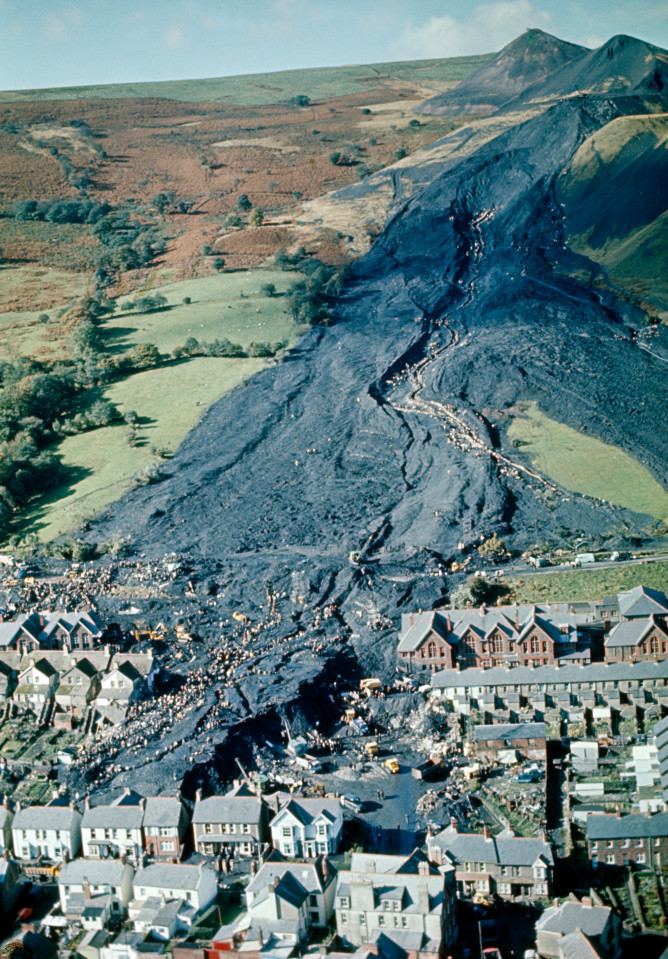
Aberfan disaster documentary
Background

For 50 years up to 1966, millions of tonnes of excavated mining debris from the Merthyr Vale Colliery were deposited on the side of Mynydd Merthyr, a ridge directly above the village of Aberfan. Spoil heaps or tips of loose rock and mining waste had been built up above a layer of porous sandstone containing several underground springs, and tips had been built up on top of the springs. Since 1947, the mine had been operated by the National Coal Board.
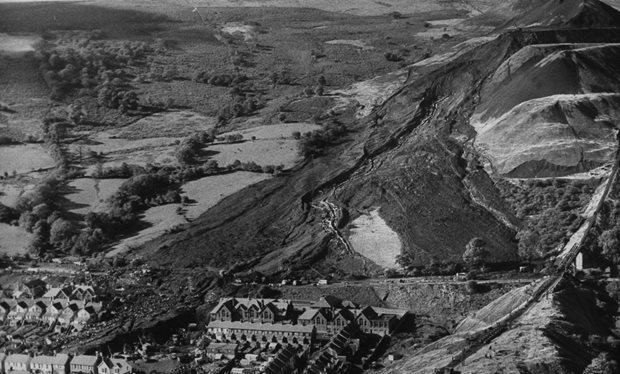
Local worries about the tip were generally dismissed. In 1964 local councillor Gwyneth Williams warned that if the tip were to move it could threaten the school. In 1965 a petition against the tip from mothers of children at Pantglas school was presented by headmistress Ann Jennings to Merthyr County Borough Council. Ms Jennings and many of the petitioners' children died in the disaster. Aberfan resident Dai Tudor said "I’ve warned and campaigned for years about that tip. Nobody in authority took any notice. This is not just the greatest tragedy in Wales. It is the biggest scandal."

One point of complaint did receive a reply. In 1963 Merthyr Tydfil Council raised specific concerns in letters to the NCB about the practice adopted in February 1962 of tailings (very fine material from colliery washeries) being included in material tipped on the mountain above the village. Because tailings tended to set hard when dry they were generally rewetted before tipping, exacerbating existing problems of flooding (in water-bearing tip waste) in the Pantglas area. Experience elsewhere in South Wales caused the Merthyr Tydfil Borough Engineer to write a letter to his superior in July 1963 expressing concerns about possible tip movement as a result of tipping tailings, which were "so fluid and the gradient so steep that it could not possibly stay in position in the winter time or during periods of heavy rain". His superior raised the issue with local colliery officials; they did not immediately identify an alternative disposal method for tailings, and tipping of tailings continued. After some correspondence the NCB Area Mechanical Engineer replied in March 1964, "As you will appreciate, these tailings are very difficult to handle and we are very careful in disposing of this material, so as not to inconvenience any person or persons, and, therefore, we would not like to continue beyond the next 6/8 weeks in tipping it on the mountainside where it is likely to be a source of danger to Pantglas School." A tip slide had occurred in the autumn of 1963; this was regarded as a 'slurry run' by the NCB and the tipping of tailings was thereafter greatly reduced but continued intermittently until early 1965. In May 1965 the NCB Area Mechanical Engineer reported to the NCB Divisional Chief Engineer "Tailings disposal at this site has ceased and are now being disposed of at Plymouth Colliery site, otherwise the tip remains stable"

Photographs, diagrams and an analysis of the 1966 flowslide, as well as locations of earlier slides at Aberfan, are given in a paper by Prof. Alan W. Bishop.
Collapse
Early on the morning of Friday, 21 October 1966, after several days of heavy rain, a subsidence of approximately 10–20 feet (3–6 m) occurred on the upper flank of colliery spoil heap No. 7. At 9.15 am more than 150,000 cubic metres (5,300,000 cu ft) of water-saturated debris broke away and flowed downhill at high speed. It was sunny on the mountain but foggy in the village, with visibility only about fifty metres (160 ft). The tipping gang working on the mountain saw the landslide start but were unable to raise the alarm because their telephone cable had been stolen. The official inquiry later established that the slip happened so fast that a telephone warning would not have saved any lives.
The front part of the mass became liquefied and moved down the slope at high speed as a series of viscous surges depositing 4,200,000 cubic feet (120,000 cu metres) of debris on the lower slopes of the mountain. Two farm cottages on the mountainside were overwhelmed, killing their occupants. Some of the mass crossed a disused canal and surmounted a railway embankment; it was subsequently estimated that about 50,000 cubic yards ( 40,000 cubic metres) of debris got beyond the embankment and entered the village. The slide struck Pantglas Junior School on Moy Road on its northern side, demolishing and engulfing much of the structure and filling classrooms with thick mud, sludge and rubble: eighteen houses on Moy Road were also destroyed.
Mud and water from the slide flooded many other houses in the vicinity, forcing many villagers to evacuate their homes. Once the slide material had been brought to a halt, it re-solidified. A huge mound of slurry up to 40 feet (13 m) deep blocked the northern end of Moy Road; lesser amounts reached Aberfan Road.
The pupils of Pantglas Junior School had arrived only minutes earlier for the last day before the half-term holiday. The teachers had just begun to record the children's attendance in the registers when a great noise was heard outside. They were in their classrooms when the landslide hit: there were heavy casualties in classrooms on the side hit.
Nobody in the village could see it, but everyone heard the roar of the approaching landslide. Some at the school thought a jet plane was about to crash and one teacher ordered his class to hide under their desks. Gaynor Minett, an eight-year-old at the school, later recalled:
It was a tremendous rumbling sound and all the school went dead. You could hear a pin drop. Everyone just froze in their seats. I just managed to get up and I reached the end of my desk when the sound got louder and nearer, until I could see the black out of the window. I can't remember any more but I woke up to find that a horrible nightmare had just begun in front of my eyes.
After the landslide there was total silence. George Williams, who was trapped in the wreckage, remembered:
In that silence you couldn't hear a bird or a child.
Pantglas County Secondary School was on the northern fringe of the affected area. Investigating the damage to it immediately after the slide, its acting headmaster found
"The Girls' Entrance was approximately two-thirds to three-quarters full of rubble and waste material . . . I climbed onto the rubble in the doorway. . . when I looked directly in front of me. . . I saw that the houses in Moy Road had vanished in a mass of tip-waste material and that the Junior School gable-ends, or part of the roof, were sticking up out of this morass. I looked down to my right and I saw that the Moy Road houses had gone. . . "
Rescue efforts and retrieval of the bodies
After the main landslide stopped, frantic parents rushed to the scene and began digging through the rubble, some clawing at the debris with their bare hands, trying to uncover buried children. Police from Merthyr Tydfil arrived soon after and took charge of the search-and-rescue operations. As news spread, hundreds of people drove to Aberfan to try to help, but their efforts were largely in vain. Water and mud was still flowing down the slope, and the growing crowd of untrained volunteers hampered the work of trained rescue teams who were arriving. Hundreds of miners from local collieries rushed to Aberfan, especially from Merthyr Vale Colliery. Miners arrived from Deep Navigation and Taff Merthyr Collieries in the neighbouring Taff Bargoed Valley. More men came from pits across the south Wales coalfield, many in open lorries with shovels in their hands, but by the time they reached Aberfan there was little they could do. A further threat was posed by a fresh torrent of water, released by two water mains, supplying the city of Cardiff, which had been fractured by the avalanche breaking through the old railway line embankment. The additional water flooded into the already saturated mounds of slurry. The flow of water was eventually stopped at 11.30 am.
A few children were pulled out alive in the first hour, but no survivors were found after 11 am.
By the next day, 2,000 emergency services workers and volunteers were on the scene, some of whom had worked continuously for more than 24 hours. Rescue work was temporarily halted when water began pouring down the slope again. Because of the vast quantity and consistency of the spoil, it was nearly a week before all the bodies were recovered.
Bethania Chapel, 250 yards (229 m) from the disaster site, became a temporary mortuary and missing persons bureau from 21 October until 4 November 1966 and its vestry was used by Red Cross volunteers and St John Ambulance stretcher-bearers. The smaller Aberfan Calvinistic Chapel was used as a second mortuary from 22–29 October and was "the final resting-place for the deceased before interment."
Two doctors examined the bodies and issued death certificates; the causes of death were typically asphyxia, fractured skull or multiple crush injuries. A team of 400 embalmers arrived on Sunday and under police supervision cleaned and prepared more than 100 bodies and placed them in coffins obtained from southern Wales, the Midlands, Bristol and Northern Ireland. The bodies were released to the families from the morning of Monday 24 October. Cramped conditions in the chapel meant that parents could only be admitted one at a time to identify the bodies of their children. One mother recalled being shown the bodies of almost every dead girl recovered from the school before identifying her own daughter.
The death toll was 144; among the dead were five teachers and 116 children between the ages of 7 and 10, equalling almost half the children on the Pantglas Junior School roll. Most victims were interred at Bryntaf Cemetery in Aberfan in a joint funeral on 27 October 1966, attended by more than 2,000 people.
Lord Robens
Chairman of the National Coal Board, Alfred Lord Robens, was a senior union official in the 1930s and a Labour MP who became Minister of Power in the final days of the Attlee Labour government. His actions immediately after the disaster and in the years that followed have been the subject of considerable criticism. When word of the disaster reached him, Robens did not immediately go to the scene but went ahead with his investiture as Chancellor of the University of Surrey. He did not arrive at the village until Saturday evening. NCB officers covered up for him when contacted by the Secretary of State for Wales, Cledwyn Hughes, falsely claiming that he was personally directing relief work when he was absent.
When he reached Aberfan, Robens told a TV reporter that nothing could have been done to prevent the slide, attributing it to natural unknown springs beneath the tip, a statement the locals challenged. The NCB had been tipping on top of springs that were clearly marked on maps of the neighbourhood, and where villagers had played as children.
Robens' evidence to the Tribunal of Inquiry was unsatisfactory; so much so that the NCB's counsel in its closing speech asked for Robens' evidence to be ignored. Robens took a very narrow view of the NCB's responsibilities regarding the remaining Aberfan tips. His opposition to doing anything more than was needed to make the tips safe, even after the Prime Minister Harold Wilson had promised villagers the tips would have to go, was overcome only by a grant from the government and a bitterly opposed and much resented contribution from the disaster fund of £150,000, nearly 10% of the money raised.
Aftermath
The traumatic effects of the disaster were wide-ranging and profound, as first-hand accounts gathered by Iain McLean and Martin Johnes indicate. During the rescue operation, the shock and grief of parents and townspeople were exacerbated by insensitive behaviour from the media – one unnamed rescue worker recalled hearing a press photographer tell a child to cry for her dead friends because it would make a good picture. The Queen and the Duke of Edinburgh visited Aberfan on 29 October to pay their respects to those who had died. The Queen received a posy from a three-year-old girl with the inscription: "From the remaining children of Aberfan". Onlookers said she was close to tears.
Anger at the NCB erupted during the inquest into the deaths of 30 of the children. The Merthyr Express reported that there were shouts of "murderers" as children's names were read out. When one child's name was read out and the cause of death was given as asphyxia and multiple injuries, the father said "No, sir, buried alive by the National Coal Board". The coroner replied: "I know your grief is much that you may not be realising what you are saying" but the father repeated:
I want it recorded – "Buried alive by the National Coal Board." That is what I want to see on the record. That is the feeling of those present. Those are the words we want to go on the certificate.
A social worker later noted that many people in the village were prescribed sedatives but did not take them when it was raining because they were afraid to go to sleep, and that surviving children did not close their bedroom doors for fear of being trapped. A doctor reported that although an expected surge in heart attacks did not occur, the trauma manifested itself in other ways – the birth rate went up, alcohol-related problems increased, as did health problems for those with pre-existing illnesses, and many parents suffered breakdowns over the next few years.
Many people suffered from the effects of guilt, such as parents who had sent children to school who did not want to go. Tensions arose between families who had lost children and those who had not. A surviving school child recalled that they did not go out to play for a long time because families who had lost children could not bear to see them, and they felt guilty that they had survived.
A study into the disaster's long-term psychological effects was published in the British Journal of Psychiatry in 2003. It found that half the survivors suffered from posttraumatic stress disorder (PTSD) at some time in their lives, that they were more than three times more likely to have developed lifetime PTSD than a comparison group of individuals who had experienced other life-threatening traumas, and that 34% of survivors who took part in the study reported that they still experienced bad dreams or difficulty sleeping due to intrusive thoughts about the disaster.
Davies Inquiry
On 26 October 1966, after resolutions in both Houses of Parliament, the Secretary of State for Wales appointed a tribunal to inquire into the disaster. It was chaired by Lord Justice Edmund Davies, who was born and brought up locally. Before the tribunal began, the Attorney General warned the media that comments on matters to be investigated by the tribunal could lay them open to the same consequences as contempt of court. The tribunal sat for 76 days; the tribunal report thought "much of the time of the Tribunal could have been saved if ... the National Coal Board had not stubbornly resisted every attempt to lay the blame where it so clearly must rest — at their door".
The tribunal retired on 28 April 1967 to consider its verdict, publishing its report on 3 August. This stated in its Introduction
"... our strong and unanimous view is that the Aberfan disaster could and should have been prevented. ... the Report which follows tells not of wickedness but of ignorance, ineptitude and a failure in communications. Ignorance on the part of those charged at all levels with the siting, control and daily management of tips; bungling ineptitude on the part of those who had the duty of supervising and directing them; and failure on the part of those having knowledge of the factors which affect tip safety to communicate that knowledge and to see that it was applied."
The tribunals findings were that:
I. Blame for the disaster rests upon the National Coal Board. This blame is shared (though in varying degrees) among the National Coal Board headquarters, the South Western Divisional Board, and certain individuals.
II. There was a total absence of tipping policy and this was the basic cause of the disaster. In this respect, however, the National Coal Board were following in the footsteps of their predecessors. They were not guided either by Her Majesty's Inspectorate of Mines and Quarries or by legislation.
III. There is no legislation dealing with the safety of tips in force in this or any country, except in part of West Germany and in South Africa.
The disregard of the NCB and the colliery staff for the tip's unstable geological conditions and its failure to act after previous smaller slides were found to have been major factors that contributed to the catastrophe. No blame lay with Merthyr Tydfil County Borough Council or the National Union of Mineworkers (NUM).
Compensation
The NCB paid out £160,000 in compensation: £500 for each fatality, plus money for traumatised survivors and damaged property.
Consequences for NCB and its personnel
If we are going to make pits safer for men we shall have to discipline the wrongdoer. I have no sympathy at all for those people—whether men, management or officials—who act in any way which endangers the lives and limbs of others.
The NCB as an organisation was not prosecuted: not until passage of the Corporate Manslaughter and Corporate Homicide Act 2007 was it possible for an organisation to be found guilty of corporate manslaughter as a result of serious management failures resulting in a gross breach of a duty of care. Nine senior NCB staff were named as having some degree of responsibility for the accident and the tribunal report was scathing in its criticism of evidence given by the principal NCB witnesses. Witnesses to Tribunals of Inquiry were effectively immune from prosecution, and no NCB staff were demoted, sacked or prosecuted as a consequence of the Aberfan disaster or for evidence given to the inquiry (one notably unsatisfactory witness had been promoted by the time Parliament debated the Davies Report); Lord Robens and the NCB board members retained their positions.
In September 1967, following the report's publication, Robens - after first mobilising support from the NUM, and checking with the government that any offer to resign would be rejected - wrote to the Minister of Power, Richard Marsh, offering his resignation. Although Robens had a combative relationship with the government and several cabinet ministers argued strongly that he should go, the Prime Minister Harold Wilson and Marsh refused to accept Robens's resignation. According to Ronald Dearing, a senior member of staff at the Ministry of Power, who briefed Marsh on the matter, the fact that Robens was "taking the coal industry through a period of painful contraction without big strikes" and the strong support for him within the coal industry and the union movement were crucial to the decision to retain him. In an interview broadcast in 2006, Marsh, described the outcome of discussions with Robens: 'We went through this and I said "Well, you send me in your resignation, and I will send you back a letter saying 'quite understand it, but I don't accept it'"'. The text of Marsh's letter had been agreed with Robens before Robens formally offered to resign.
Leo Abse spoke for many other critics: "..when I saw what I regarded as the graceless pavane danced by Lord Robens and the Minister, as the Chairman of the Coal Board coyly offered his resignation and, equally coyly, the Minister rejected the offer, I thought that it was a disgraceful spectacle."
Disaster fund
The public demonstrated its sympathy by donating money with little idea of how it would be spent. Donations flooded in to an appeal initiated by the Mayor of Merthyr Tydfil and within a few months, nearly 90,000 contributions had been received, totalling £1,606,929 (equivalent to £27 million in 2015). Management of the fund caused considerable controversy over the years. The fund was put on a firm legal footing under the auspices of a permanent committee with clear local representation and a trust deed that specified the money was to be used:
1. For the relief of all persons who have suffered as a result of the said disaster and are thereby in need.
2. Subject as aforesaid for any charitable purpose for the benefit of persons who were inhabitants of Aberfan and its immediate neighbourhood (hereinafter called 'the area of benefit') on the 21st day of October 1966 or now are or hereafter become inhabitants of the area of benefit and in particular (but without prejudice to the generality of the last foregoing trust) for any charitable purpose for the benefit of children who were on the 21st day of October 1966 or who now are or hereafter may become resident in the area of benefit.
Many aspects of the aftermath of the disaster remained hidden until 1997, when the British Public Records Office released previously embargoed documents under the thirty-year rule. The documents revealed new information about the actions of Lord Robens, the NCB and the Charity Commission in the wake of the disaster.
At one point the Charity Commission "duty-bound to uphold an outdated and inflexible law", intervened and obstructed payments by the fund to individual victims and for the cemetery memorial. Commission staff considered whether to insist that before any payment was made to bereaved parents, each case should be reviewed to ascertain if the parents had been close to their children and were likely to be suffering mentally. At another meeting, the commission threatened to remove trustees of the disaster fund or make a financial order against them if they made grants to parents of children who had not been physically injured that day, and the trustees were forced to abandon the payments.
In the Commons debate on the Inquiry Report it was asserted by the Government on the advice of the NCB and supported by comments in the tribunal report that the remaining tips above Aberfan were not dangerous and did not warrant removal (estimated by the tribunal to cost £3 million), but merely required landscaping, a much cheaper option. The assertion was promptly contradicted by the local MP, S.O. Davies; as Margaret Thatcher pointed out the report noted that "One may conclude that No. 5" (tip) "has been standing and is standing at a very low factor of safety." Despite the government opposition, public pressure led to a decision to remove the remaining tips: the Secretary of State for Wales stressed that they were safe but that he knew from contacts with the people of Aberfan "that they constitute a psychological, emotional danger". If the tips were not physically dangerous, Robens saw no obligation on the NCB to pay the cost of their removal. The government made a grant of £200,000 towards the cost of removing the tips, and under "intolerable pressure" from the government, the trustees of the disaster fund agreed to contribute £150,000. At the time, the Charity Commission made no objection to this action, but it has subsequently been criticised as "unquestionably unlawful" under charity law.
An important part of the fund is still alive and running. The disaster committee set up a fund to help pupils and it is still available for pupils from the village or for children whose parents were living in Aberfan at the time of the disaster.
Shortly after the disaster children and staff at the primary school at Spellbrook, near Bishops Stortford, Hertfordshire, collected £20–16s–0d (£20.80) for trees to be planted on a nearby tip. The forest plantation remains to this day.
Legislation
As a result of concerns raised by the disaster, and in line with Finding XVII of the Davies Report, in 1969 the British government framed new legislation to remedy the absence of laws and regulations governing mine and quarry waste tips and spoil heaps. The Mines and Quarries (Tips) Act 1969 was designed "to make further provision in relation to tips associated with mines and quarries; to prevent disused tips constituting a danger to members of the public; and for purposes connected with those matters".
The Act was an extension of the earlier Mines and Quarries Act 1954. As the Davies Tribunal had found, the Act did not mention tips in its provisions, the only reference to public safety was a section dealing with fencing abandoned or disused mines and quarries to prevent people falling into them. Under the terms of the 1954 Act, the Aberfan disaster was not required to be formally reported to HM Inspectorate of Mines and Quarries because it did not take place on colliery property and no mine workers had been injured or killed.
To address the problem of safety legislation being largely reactive, health and safety legislation was put on a different footing with the passage of the Health and Safety at Work etc. Act 1974. It established a catch-all general duty on employers (with a similar clause for the self-employed) "to conduct his undertaking in such a way as to ensure, so far as is reasonably practicable, that persons not in his employment who may be affected thereby are not thereby exposed to risks to their health or safety." The Act addressed the recommendations of a committee set up by Barbara Castle to look at modernising UK health and safety legislation. The committee was chaired by Lord Robens.
Subsequent events
Merthyr Vale Colliery closed in 1989. In 1997 the incoming Labour government of Tony Blair repaid to the disaster fund the £150,000 that it had been induced to contribute, by the Labour government of Harold Wilson, towards the cost of tip removal. No allowance was made for inflation or the interest that would have been earned over the intervening period.
On 9 May 1997 the Queen and the Duke of Edinburgh planted a flowering cherry tree at the Aberfan Memorial Garden. The Queen spoke to the largest ever gathering of survivors and relatives of the victims. Many of them were meeting for the first time since the day of the disaster. The memorial garden is on the site of Pantglas Junior School and includes stone walls to show where the classrooms stood.
In 2005 Imperial Tobacco settled out of court to end a wrongful dismissal suit brought against the company by an Aberfan survivor Janice Evans, who had been employed by Imperial's Rizla cigarette paper factory near Pontypridd. Evans had been sacked after she refused to continue working night shifts, alleging that it had brought on flashbacks of her ordeal in 1966, when she had been buried waist-deep in the landslide while walking to school. Although Evans survived, a friend who had been walking with her was killed.
In February 2007 the Welsh Government announced a donation of £1.5 million to the Aberfan Memorial Charity and £500,000 to the Aberfan Education Charity. No connection was made to the shortfall of the 1997 repayment.
